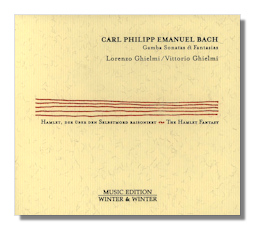
The Internet's Premier Classical Music Source
Related Links
- C.P.E. Bach Reviews
- Latest Reviews
- More Reviews
-
By Composer
-
Collections
DVD & Blu-ray
Books
Concert Reviews
Articles/Interviews
Software
Audio
Search Amazon
Recommended Links
Site News
 CD Review
CD Review
Carl Philipp Emanuel Bach

Gamba Sonatas & Fantasias
- Fantasy for Keyboard in A Major, Wq 58/H 278
- Piece for Keyboard in D minor "La Stahl", Wq 117 #25/H 94
- Free Fantasy in C minor with Hamlet's Monologue, Wq 202m/H 75 1
- Piece for Keyboard in C minor "Les langueurs tendres", Wq 117 #30/H 110
- Sonata for Viola da gamba & Continuo in D Major, Wq 137/H 559
- Sonata for Viola da gamba & Harpsichord in G minor, Wq 88/H 510
- Sonata for Viola da gamba & Continuo in C Major, Wq 136/H 558
Vittorio Ghielmi, viola da gamba
Lorenzo Ghielmi, fortepiano
1 Gianluca Buratto, bass-baritone
Winter & Winter 910140-2
In 1753 Carl Philipp Emanuel Bach published his Essay on the True Art of Keyboard Playing. It contained 18 sample pieces which truly reveal the composer at his most expansive and self-confident. Indeed, if you are new to it, you'd probably be hard-pressed to assign something as romantic, almost, and unconventional as the "Free Fantasy" in A Major, Wq 58/H 278 [tr.4] to a Bach.
That's what this welcome CD from Lorenzo and Vittorio Ghielmi (brothers) emphasizes: C.P.E. Bach's free-spiritedness. Nowhere could this be more explosively communicated than in the rarely-heard "Hamlet" Fantasia Wq 202m/H 75 [tr.8], when a bass-baritone appears, from nowhere, to sing the soliloquy (a text actually by Heinrich Wilhelm von Gerstenberg (1737-1823); "To be, or not to be"). This isn't so capricious as it sounds: it highlights the concerns of both composers and writers of the time with (new) ways in which instrumental music could deal with ideas which would otherwise be expressed verbally. Indeed, in most of the other movements on this CD can be discerned a descriptiveness and implicit allusion to the kind of development of musical ideas (phrasing, key and structure in particular) that were to surface in the German Lied a generation or so later.
Such attention to expressivity that Bach paid is at the forefront of the performances here. After all, the freedom engendered in the Fantasia to which Bach alluded with great enthusiasm in the Essay on the True Art of Keyboard Playing, although not new, is examined in new ways in these pieces. Such innovations address melody and texture to be sure; but to listen to the variety of invention in each of the seven works played here is effectively to marvel at a composer who is not only fully aware of the possibilities of his instruments; but also desirous of drawing as much as possible out of the forms and juxtapositions of each.
The Ghielmis are completely in accord with these pre-occupations. Their playing is technically very accomplished (some of the gamba parts call for considerable virtuosity). It is also exploratory, inquisitive and probing in the way that only this combination of instruments can be. As if, at times (for example in the arioso of the C Major sonata, Wq 136/H 558, [tr.12]) they are reading it for the first time. Since we have reason to believe that this spontaneity and open-endedness was one of the aspects of his writing which Bach wanted to convey, this is all to the good.
This is not a CD of purely "novel" or "experimental" music in any way, though. Still less one which might spuriously suggest a "concept". It is C.P.E. Bach's music with all its solidity and self-assurance. There is great beauty, tenderness and sensitivity: the way the melody of "Les langueurs tendres" Wq 117 #30 in C minor, H110 [tr.13] is almost stroked into our hearing adds to its impact almost as a very short coda to the whole CD – as if to emphasize that when C.P.E. Bach wrote this music, nothing quite like it would ever be written again.
Lorenzo Ghielmi plays a fortepiano by Andrea Restelli (from Milan) of 1996 after a Gottfried Silbermann of 1749. Vittorio Ghielmi an "anonymous" seventeenth century bass viol from Southern Germany. These sound particularly well in this warm and inviting music. There is an excellent recording of the three sonatas only (Wq 137/H 559; Wq 88/H 510; Wq 136/H 558) on Naxos 8.570740 by Peter Laul and Dmitry Kouzov. But the current collection by the Munich-based Winter & Winter label that otherwise specializes in jazz and improvised music goes further, with all the style and technique needed (and a useful introductory essay, and a nice, close recording) to expose this music as it deserves. It can be thoroughly recommended.
Copyright © 2009, Mark Sealey




















